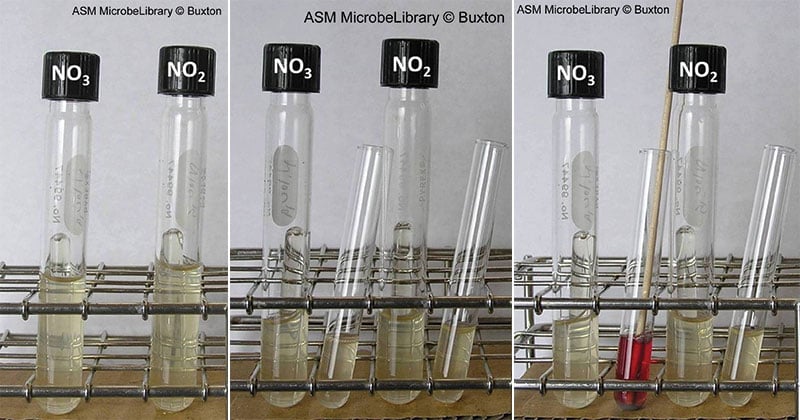Interesting Science Videos
Objective
To determine the ability of an organism to reduce nitrites to gaseous nitrogen or to other compounds containing nitrogen.
Principle of Nitrite Reduction Test
Nitrate reduction by bacteria is mediated by nitrate reductase and indicates that the organism can use NO3– as an electron acceptor during anaerobic respiration and reduce nitrate to nitrite. Nitrite, on the other hand, maybe reduced to a variety of nitrogen products including NO, N2O, N2, and NH3, depending on the enzyme system of the organism and the atmosphere in which it is growing. Microorganisms capable of reducing nitrite to nitrogen do not turn color but the production of gas is visible in the nitrite reduction test.
N2 gas is usually visible in the Durham tube. In the absence of gas, the product is assumed to be other than N2 gas. The reduction of nitrite is determined by adding sulfanilic acid and alpha-naphthylamine. After the addition of the reagents, no red coloration in the test tube and the presence of gas in the Durham tube indicates a positive test indicating nitrite reduction to nitrogen gas. The test does not require the addition of zinc dust.
Media Used
Brain-heart infusion broth (2 g), pancreatic digest of casein (10 g), peptic digest of animal tissue (5 g), yeast extract (3 g), NaCl (5 g), NaNO2 (0.1 g), per 1000 mL, pH 6.9.
Nitrite reduction medium
| Beef extract | 3.0g |
| Gelatin peptone | 5.0g |
| Potassium nitrite (KNO 2) | 1.0g |
| Deionized water | 1000ml |
Procedure of Nitrite Reduction Test
- Inoculate nitrite broth with organism from a 24-hour broth culture.
- Incubate for 48 hours at 35°-37°C.
- Examine 48-hour nitrite broth cultures for nitrogen gas in the inverted Durham tube and add 5 drops each of the nitrate reagents A and B to determine whether nitrite is still present in the medium.
Results of Nitrite Reduction Test

Image Source: ASM
Positive test: No color change to red 2 minutes after the addition of the reagents; gas production in the Durham tube.
Negative test: The broth becomes red after the addition of the reagents; no gas production.
Limitations of Nitrite Reduction Test
If the broth does not become red and no gas production is observed, zinc dust is added to determine if the nitrite has not been oxidized to nitrate (thus invalidating the test). If oxidation has occurred, the mixture turns red after the addition of zinc.
Quality Control
Positive: Proteus mirabilis (ATCC12453): colorless, gas production
Negative: Acinetobacter baumannii (ATCC19606): red coloration, no gas production
References
- Tille P.M. 2014. Bailey and Scott’s diagnostic microbiology. Thirteen edition. Mosby, Inc., an affiliate of Elsevier Inc. 3251 Riverport Lane. St. Louis. Missouri 63043
- Buxton R. 2011. Nitrate and nitrite reduction test protocols
- http://www.asmscience.org/content/education/protocol/protocol.3660
